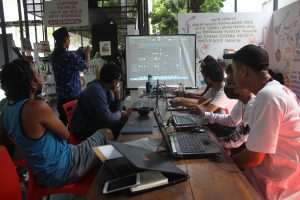Stumbling to follow the steps of composing electronic music, he approached me. While guiding my fingers to press the correct button, he said, “We are waiting for those who can’t make it yet. It’s okay to be late, as long as we’re together.”
He was Asep Nayak in the middle of the Wisisi Dance Workshop on Sunday (17/10) at the Kitchen Work Area 56 Jogja National Museum (JNM).
Starting at 01.30 p.m, Asep guides a workshop on composing Wisisi’s music.
“There is no specific meaning. The point is, Wisisi is a solace,” he said about the meaning of Wisisi.
Starting from a music performance that was initiated by a musician named Nikolas Wiligma in Wamena, he began to cultivate Wisisi. It started in 2013. Armed with a laptop, he fiddled with the Fruity Loops Studio application, teaching himself how to use the thing. it’s the application that he uses to this day, including during workshops.
After the orientation about Wisisi, the workshop started with developing basic patterns. A total of 6 patterns were guided by Asep and then followed by the five workshop participants who attended. After that, was inserting variations.

Peserta lokakarya khidmad menyimak penjelasan Asep Nayak melalui layar proyekto.
“This is what I’ve been waiting for. Variation!” said Wok The Rock as one of the participants.
Not only him, but all the participants were also very enthusiastic in concocting the variations. A participant named Wihandoko plugged in headphones. He wanted to savor it.
Meanwhile, Syuja Amanullah and Mayong Bibakkati, who were also participants, occasionally turned their ears to the earpiece of their laptop. They wanted to listen to the tunes of his creations.
“Take that speaker cable. Plug it in, turn on my music,” said Hahan, also known as Wihandoko, to me, who had turned off the laptop in a sign of surrender. Beginning with a sound such as a triangle or the knocking of a glass bottle, Han’s Wisisi reverberated across the room, which then gets a thumbs up from Asep.
The next exhibition of works was held by Mayong and Syuja. Both were experimenting. Mayong tinkered with the ambient sounds from his former film project. Meanwhile, Syuja placed the snare percussion at the end of Wisisi.
Mayong and Syuja had originally intended to participate in this workshop.
“This is the first time I listened to Wisisi, and I’m interested in Eastern music because of its unique tone,” said Mayong about his interest in the Wisisi workshop.
In the future, they don’t know whether they want to continue exploring Wisisi’s tunes or not.
“But I’m curious about Wisisi’s development in the Indonesian music scene in the future,” said Syuja.
After the lunch session at Dapur 56, the workshop continued until 05.30 p.m. Four hours lasted, with no participant taking early leave. Including me, although I didn’t progress much. In fact, after the event, Hannah wanted to take notes and talk further about concocting Wisisi with Asep.
Indeed, in addition to washing away sadness, Wisisi can also make you forget the time. Like Asep, who admits that he forgets to eat when he is concocting Wisisi’s music.
“You can make Wisisi music at home, as long as you don’t forget to lift the clothesline,” Gintani Nur Apresia Swastika, Director of Biennale Jogja XVI Equator #6 2021, reminded.